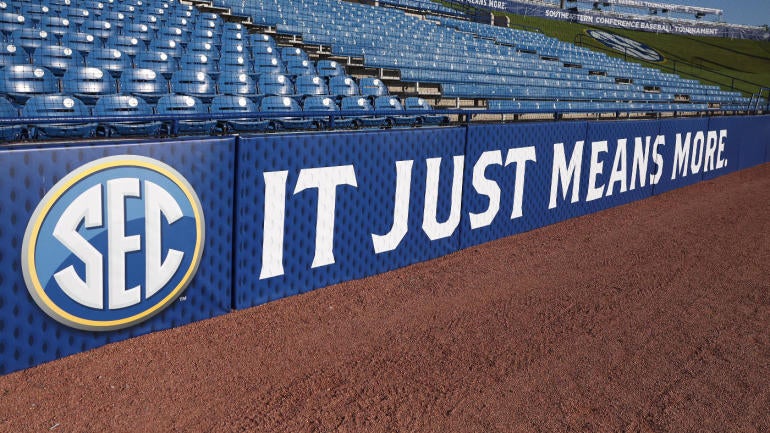
DESTIN, Fla. — Josh Booty could have had it all.
When former LSU baseball coach Skip Bertman recruited Booty 30 years ago, the offer was not only a scholarship, it was essentially to play shortstop for the defending national champions.
Ah, but the blue-chip prospect out of Shreveport, Louisiana, was going to play quarterback (on scholarship) and start basically as a walk-on in baseball. Who would pass that up? Heck, playing both sports at a high level worked for Bo Jackson. Why not Booty?
“If you want to play baseball I’ll give you a full [baseball] scholarship,” Booty recalled the legendary Bertman saying. “But why would I not put you on football [scholarship] and make a better team out of [baseball]?”
Baseball intervened without Booty ever taking a ground ball at Alex Box Stadium. The Florida Marlins came with a then-record $1.6 million offer for him to go pro.
Five years and all of 30 MLB plate appearances later, Booty came back to play quarterback for the Tigers in 1999 for two seasons. In that sense, Booty did have it all. The kid, now a 49-year-old entrepreneur, played football for Nick Saban — but not without a lesson.
College baseball was underserved. Only four programs in the country make money according to U.S. Department of Education figures assembled by consultant Tony Altimore. The scholarship thing, well, that’s been unique. It’s damn hard to manage them on a Division I roster.
The NCAA Baseball Tournament begins this week with a record 11 SEC teams in the 64-team field. That’s an ongoing salute to all the Division I coaches who try to micro-distribute 11.7 scholarships over 35 roster spots. That distribution model makes baseball an “equivalency” sport. FBS football is a “head count” sport awarding full scholarships for each available roster spot.
The only head count sports in Division I are FBS football, men’s and women’s basketball, women’s tennis, women’s gymnastics and women’s volleyball. The rest are equivalency sports where coaches have agonized for decades on how to split up those scholarships.
This might be the last time they have to do it.
The last NCAA championship on the annual calendar is about to become a referendum on the future of what amounts to two factions following the landmark House v. NCAA settlement. Baseball scholarships are about to be fully funded with the resulting revenue sharing money. Meanwhile, there is emerging talk that football rosters will be capped at 85 scholarships. That does a couple of things – potentially wiping out football walk-ons while balancing rosters to address Title IX concerns in the settlement.
Gentlemen, start your hand-wringing.
“Business as usual is over,” Texas A&M AD Trev Alberts told reporters Tuesday. “It’s a new model.”
As part of the settlement reached last week, there is a discussion to be had about scholarship caps being replaced by roster limits. It’s complicated because on one end Power Four schools will be on the hook for $22 million annually in revenue sharing money. At the same time, Alberts and his peers will have to consider de-emphasizing or cutting sports to make ends meet and address Title IX concerns.
It’s all “permissive”, meaning optional, but is there any doubt the SEC is all in on adding minor scholarships?
“I think it’s way too soon to make any type of speculation of what people are really going to end up doing [but] I know the SEC, whatever it is, they’re going to do it,” said Craig Keilitz, executive director of the American Baseball Coaches Association.
The dichotomy comes from putting any kind of brakes on football. “It just means more” in the SEC. At these same spring meetings a few years ago, football coaches practically lost their minds over the prospect of Auburn players maybe getting $100 more per month in cost of attendance money.
While the rest of the college world worries over what to do next, the SEC has the same plan it always has: Whatever it takes.
“Everybody will do it. If you can do it, you’ve got to do it,” Booty said of the increased baseball scholarships.
This isn’t just about baseball. What’s about to take place is arguably the most massive financial adjustment in college sports history – again, as a condition of that massive settlement.
There’s one part of the discussion about how NCAA and campus leadership ever let it get to this point. The $2.8 billion House settlement will cost all of Division I in one way or another. Now it’s just a case of finding the money to do it.
“I’m strongly against it,” Texas A&M football coach Mike Elko said addressing the prospect of losing walk-ons. “I think it’s absolutely against college football, what it stands for, what it’s about, especially when you look at legacies of Texas A&M kids that are going to get the opportunity to play football at Texas A&M potentially taken away from them. I think that’s something that’s really bad for the sport.”
At Texas A&M, a significant part of the football program’s tradition is based on the ultimate walk-on, the famed “12th Man,” after a player who came out of the stands to win a game in 1922.
USATSI
“We’re in this era of college football where we have to continually adapt …,” Texas football coach Steve Sarkisian said. “If we don’t adapt, we aren’t going to be here. If that’s the number, that’s the number.”
Coastal Carolina AD Matt Hogue oversees both a national baseball program – the Chanticleers were the 2016 national champion – but also an elite Group of Five football program. After the settlement money clears, will either ever be the same again?
Should they be the same? We’ve already told you the inexorable separation of FBS taking place. NIL for the top shelf programs is evolving in unique ways.
“I would anticipate anyone right now that is fully engaged will reset the bar on what fully engaged means,” Hogue said.
All of it has spawned talk of an NFL model in the wake of the settlement. We’re already halfway there seemingly with rules, rosters and, now revenue sharing.
“That can be the carnage of not getting it right …,” Oklahoma coach Brent Venables said. “I like how it is. But I do know it’s not going to stay the same.”
College baseball has always been that sort of Americana niche where anyone could win. The SEC is the nation’s power conference but in the last 20 years Rice and Cal State-Fullerton have won it all. In that span, Oregon State became a national power.
And for years, minor sports coaches have agonized over splitting up those scholarships. There is anecdotal evidence of athletes and their parents shopping “deals”. One school might offer half a scholarship. One might offer a quarter or an eighth. Now?
“We’re in the golden age right now of college baseball …,” Keilitz said. “We’ve never been as good as this. I think it’s going to take another huge jump.”
It was a completely different climate in football 50 years ago. In an era of unlimited scholarships is the famous tale of Bear Bryant recruiting an Auburn quarterback prospect with no particular intention of playing him just to keep him away from the Tigers.
The first football scholarship limitations came in 1973 (105 scholarships), in response to Title IX. In 1978, they were sliced to 95. By 1994, they were cut to the current 85.
Coaches like Bobby Bowden (Florida State) and John McKay (USC) predicted the end of quality football with those cuts. They were dead wrong. Back then it was about cost cutting, competitive equality and adherence to Title IX.
Today, the conversation has changed to give the players more money – per the settlement — than they’ve ever dreamed of for playing college sports.
“I hear coaches talk about [the situation], but that’s life,” Keilitz said. “They do the same thing with their employers. I heard a football coach who is making $11 million complaining that, hey college is about giving you an opportunity to make a living down the road … I’m against paying players. And the coach is making $12 million a year.”
The House settlement has exposed the hypocrisy and mismanagement. According to reports, schools will not only be forced to spend $22 million annually in revenue sharing, there will be another $8 million to $10 million needed annually to fully fund those minor sports scholarships.
“We’re not very good at running good businesses,” Alberts said. “We’ve just always had enough increasing revenue to overcome expenses … Does this reframe our thinking, create some discipline? Heretofore it hasn’t. Based on this new reality, the flow of money is going to change.”
It’s early. Extremely early. The revenue sharing part of this may not hit until fall 2025. College baseball probably wouldn’t be impacted until the 2026 season. The roster expansion part of it is a convoluted part of that revenue sharing. And if the lid is going to be put on antitrust lawsuits – it certainly isn’t by the House settlement alone — athletes and their representatives must be mollified.
You might even say, they are all on the brink of having it all.
“I’m a little jealous of student-athletes,” said Alberts, a former All-American linebacker at Nebraska. “The life of a student-athlete … is going to be at a level that is unprecedented.”
This post was originally published on this site be sure to check out more of their content.




